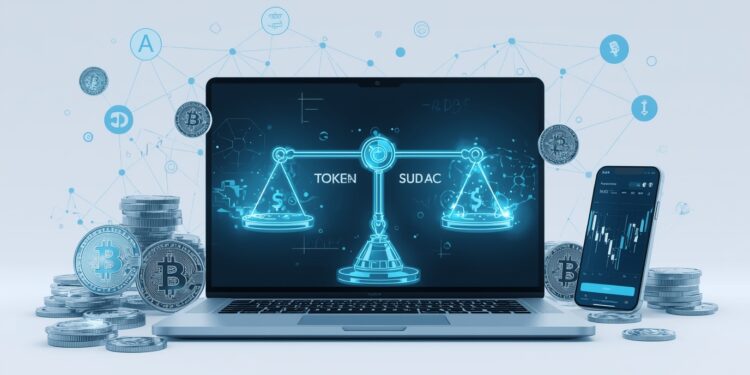If you’ve ever swapped tokens on Uniswap or PancakeSwap, congratulations—you’ve already used an Automated Market Maker (AMM). But what exactly is an AMM? Why has it become a cornerstone of decentralized finance (DeFi)? And how does it work behind the scenes?
In this blog, we’ll break down the concept of Automated Market Makers in simple, approachable terms. By the end, you’ll understand what makes AMMs so powerful, how they differ from traditional exchanges, and what risks and rewards they offer users and liquidity providers.
The Basics: What Is an AMM?
An Automated Market Maker (AMM) is a type of decentralized exchange (DEX) protocol that uses smart contracts to facilitate trades without relying on a traditional order book. In other words, AMMs enable users to buy and sell cryptocurrencies directly from liquidity pools, not from other traders.
Instead of matching buyers with sellers, AMMs use mathematical formulas to determine prices. They allow anyone to become a market maker by providing liquidity to trading pairs, and they automatically execute trades based on supply and demand.
Why AMMs Were Created: The Problem With Traditional Exchanges
In traditional finance and centralized exchanges like Coinbase or Binance, trades happen through order books. Buyers and sellers submit their price and quantity, and the platform matches them. This system works well but comes with several downsides:
- Requires a middleman (the exchange) to match orders
- Limited trading hours (in traditional finance)
- Vulnerable to manipulation and centralized control
- Needs high liquidity to work efficiently
Decentralized exchanges needed a way to avoid these problems. Enter AMMs—a way to trade tokens without an intermediary and without relying on order books.
How Do AMMs Work?
At the core of AMMs are liquidity pools. These pools are essentially smart contracts containing reserves of two (or more) tokens, such as ETH and USDC. When you trade on an AMM, you interact with the pool directly—not with another user.
Here’s how it works:
- Liquidity Providers (LPs) deposit tokens into the pool (e.g., 50% ETH, 50% USDC).
- The AMM uses a pricing algorithm (like x * y = k in Uniswap V2) to determine the exchange rate.
- When a user swaps tokens, the ratio of assets in the pool changes, which automatically changes the price.
- LPs earn a portion of the trading fees in return for supplying liquidity.
The Magic Formula: x * y = k
The most well-known AMM pricing formula comes from Uniswap V2:
x * y = k
Where:
xis the amount of Token A in the poolyis the amount of Token B in the poolkis a constant that remains the same
Let’s say you’re swapping ETH for USDC. If you add ETH to the pool, it reduces the USDC you get in return—because the total product of ETH and USDC must stay constant (k). This creates a natural mechanism for adjusting prices based on supply and demand.
Popular AMM Platforms
Several DeFi platforms have implemented AMMs with slight variations. Some of the most popular include:
- Uniswap – Pioneer of AMMs with a focus on Ethereum-based tokens.
- PancakeSwap – Built on BNB Chain; known for lower fees and gamified features.
- Curve Finance – Optimized for stablecoin trading with minimal slippage.
- Balancer – Allows custom pool ratios (e.g., 80/20 instead of 50/50).
- SushiSwap – A fork of Uniswap with added community incentives.
Each protocol adds its own twist, but they all follow the core AMM logic—no order books, no middlemen.
Liquidity Providers: Heroes Behind the Scenes
Without liquidity providers (LPs), AMMs wouldn’t function. LPs deposit equal values of two tokens into a pool and earn a share of trading fees. It’s a passive income opportunity, but not without risk.
Benefits for LPs:
- Earn fees on every trade in the pool
- Some platforms offer additional token incentives
- Passive exposure to DeFi markets
Risks for LPs:
- Impermanent Loss: Happens when the value of tokens in the pool diverge compared to simply holding them.
- Smart Contract Risks: Bugs or exploits can lead to loss of funds.
- Market Volatility: Can impact returns or lead to unexpected losses.
Many new LPs don’t fully understand impermanent loss until they experience it. It’s not always “loss” in the permanent sense, but it can eat into profits significantly.
AMMs vs Order Book Exchanges
| Feature | AMMs | Order Book Exchanges |
|---|---|---|
| Trading Mechanism | Algorithmic via liquidity pools | Direct matching of buy/sell orders |
| Intermediary Required | No | Yes (exchange platform) |
| Liquidity Source | Users providing token pairs | Traders placing orders |
| Price Determination | Math formulas (e.g., x*y=k) | Market demand/supply |
| Slippage | Higher with large trades | Generally lower |
| Gas Fees (on Ethereum) | Higher | Varies |
Innovations and Variations in AMMs
As DeFi matures, AMMs are evolving rapidly. Some newer innovations include:
1. Concentrated Liquidity (Uniswap V3)
Instead of providing liquidity across all price ranges, LPs can concentrate it where most trading happens, earning more fees efficiently.
2. StableSwap (Curve)
Curve uses a different formula for stablecoins, which reduces slippage and improves price accuracy.
3. Dynamic Fees
Some AMMs adjust fees based on market conditions to protect LPs during high volatility.
4. Multi-Token Pools (Balancer)
Unlike traditional 50/50 pools, Balancer allows pools like 80/20 or 60/20/20, offering more flexibility.
These developments aim to reduce risk, improve capital efficiency, and make AMMs more attractive to users and LPs alike.
Use Cases of AMMs
AMMs aren’t just for token swaps. They unlock several use cases in DeFi:
- Yield Farming: Earn platform-native tokens by providing liquidity.
- Token Launches: Projects launch new tokens via liquidity pools (e.g., IDOs).
- Synthetic Assets: Trade tokenized stocks or commodities.
- Stablecoin Trading: Efficient swapping between USDT, USDC, DAI, etc.
- Cross-Chain Swaps: AMMs on chains like Avalanche or Arbitrum allow seamless decentralized trading.
Risks and Limitations of AMMs
Despite their benefits, AMMs have notable limitations:
1. Impermanent Loss
The biggest risk to LPs. If token prices diverge heavily, LPs might end up with less total value than simply holding the tokens.
2. Front-Running (MEV)
Bots can exploit transaction order on public blockchains, executing profitable trades before yours.
3. High Gas Fees
On networks like Ethereum, trading or providing liquidity can be costly.
4. Smart Contract Bugs
Even audited contracts aren’t 100% safe. Hacks and vulnerabilities can result in fund losses.
Being aware of these risks is key to using AMMs wisely.
The Future of AMMs
As the DeFi ecosystem matures, AMMs are expected to become more sophisticated and user-friendly. Some trends to watch include:
- Cross-chain liquidity aggregation
- Layer-2 AMMs with lower fees
- AMMs with integrated lending/borrowing
- AI-assisted liquidity management
- More regulatory clarity
We may even see hybrid models that combine order books and AMMs for better performance.
Final Thoughts
Automated Market Makers have revolutionized the way we trade crypto. By removing intermediaries and relying on code, they empower anyone with an internet connection to swap tokens, earn fees, or launch projects.
But they’re not magic. Like all DeFi tools, AMMs come with trade-offs. Understanding how they work—from the math behind them to the risks LPs take—can help you make smarter decisions in this new financial frontier.
Whether you’re a trader, investor, or just curious about DeFi, AMMs are worth exploring. They represent a fundamental shift toward an open, permissionless, and programmable financial system.
Join Us : Twitter | Website | GitHub | Telegram | Facebook | YouTube

























